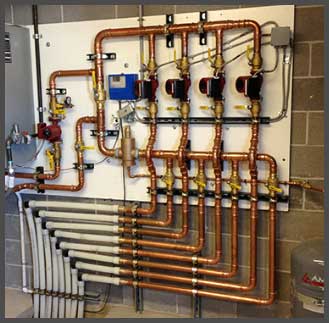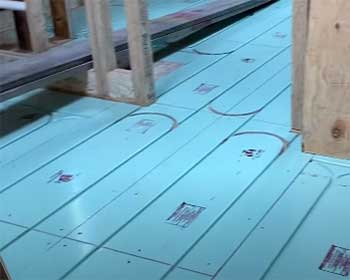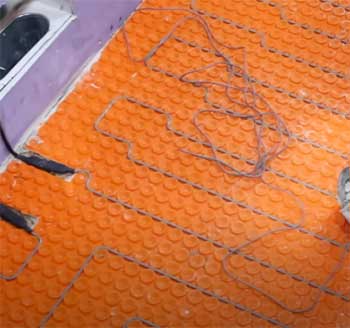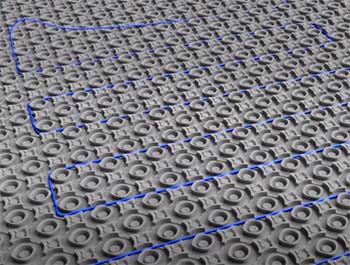Radiant floor heating systems like Crete-Heat are becoming increasingly popular for heating homes and other buildings. Embedded in a concrete floor or thin slab, radiant systems provide even, comfortable heat without the draftiness of forced air.
But Crete-Heat is just one of many options for in-floor radiant heat. Here, we’ll explore the pros, cons, costs, and considerations for Crete-Heat and other radiant floor heating system alternatives.
Alternatives To Crete-Heat
Here is a list of those worthy equivalents:
- Embedded Hydronic Systems
- Warmboard
- Nuheat Concrete Slab
- Schluter Ditra-Heat
- Nuheat Thin Slab
- SunTouch Wire
- Warmboard Subfloor
- Nuheat Subfloor
Let’s talk about them in detail:
Embedded Hydronic Systems

Like Crete-Heat, these hydronic radiant systems embed pipes directly in a concrete floor slab.
Hot water warms the concrete, which then gently heats the room above.
Pros:
- Even, comfortable heat
- Long lifespan if installed correctly
- Can be controlled room-by-room
Cons:
- Higher upfront cost
- Installation can be complex
- Not compatible with some floorings
Warmboard

Warmboard is a popular and effective alternative to Crete-Heat.
It consists of aluminum heat transfer plates that have channels factory-installed for the PEX tubing.
The tubing snakes through these channels, allowing for excellent heat conductivity to the concrete poured over the Warmboard.
The aluminum plates come in 4×8 or 4×10 foot panels in various thicknesses (3/8, 1/2, or 5/8 inches). They simply lay over the slab or subfloor, with the tubing pressed into the channel grooves.
The close contact between the tubing and aluminum allows outstanding heat transfer. Concrete gets poured over the panels to a minimum of 1.5 inches thick.
Warmboard requires less concrete pour depth than traditional Crete-Heat, for faster heating response time. Many homeowners install Warmboard themselves, but professional installation is recommended for best results.
Nuheat Concrete Slab
Nuheat offers a simple grid hydronic piping system designed for concrete slab radiant floor heating. Flexible PEX tubing gets laid out in parallel lines, using plastic clips to hold a consistent spacing. Tubing gets centered in the concrete slab.
When the concrete is poured, the piping presses up into the concrete, ensuring close contact with the slab. Concrete should fully cover the piping by at least 1.5 inches. This type of piping installation allows for variable spacing – tubing can be placed closer together in high heat load areas.
A key advantage of Nuheat is the lower profile tubing compared to Warmboard. This allows for a thinner concrete slab overall.
However, care must be taken during pouring to avoid excess weight or sharp aggregate damaging the tubing.
Schluter Ditra-Heat

The Schluter Ditra-Heat system provides an easy-to-install thin slab alternative to Crete-Heat.
It uses a polyethylene membrane with a dovetail pattern that secures flexible PEX tubing in place.
The membrane rolls out over the subfloor or existing slab, with tubing pressed into the dovetailed channels at regular intervals.
The membrane is only 5/16” thick, so just a thin layer of concrete or gypsum is needed on top, keeping the profile low.
Ditra-Heat installs faster than traditional wire mesh and rebar systems. And the tubing can be custom spaced based on room layouts. The system works well for renovations, as it adds minimal floor height.
Nuheat Thin Slab
For a thin slab radiant alternative, Nuheat offers a low-profile system with PEX tubing secured to galvanized aluminum plates or a fiber-reinforced polymer board.
On the metal heat transfer plates, tubing presses into grooved channels for direct contact, similar to Warmboard. For the polymer board, tubing attaches with plastic clips. This spacing can be adjusted as needed.
The tubing and plate system gets covered with a thin layer of gypsum or concrete at least 3/4″ thick. This is far thinner than a standard Crete-Heat slab, allowing rapid heat-up and response.
Customizable tubing layouts help tailor heat to room layouts.
SunTouch Wire

SunTouch uses thin electric heating wires instead of hydronic tubing to provide simple, low-profile radiant floor heat.
The system sandwiches the wires between two thin aluminum plates.
These plates distribute warmth evenly across the floor.
The plates come in widths from 7.5 to 11.75 inches to handle various room layouts.
The plates get installed onto the slab or subfloor, then embedded in a thin layer of gypsum or concrete at least 5/8” thick. The layers can be as thin as 1/4″ over a wood subfloor. An advantage over hydronic systems is no need for controlling pumps or boilers.
Warmboard Subfloor
The aluminum Warmboard panels fasten to the subfloor. Tubing presses into heat transfer grooves for direct contact with the flooring.
Pros:
- Compatible with any floor covering
- Faster installation than slab systems
Cons:
- Less efficient heat transfer than slab systems
- Floor may feel “hollow”
Nuheat Subfloor
PEX tubing snakes between aluminum heat transfer plates spaced on the subfloor, then gets covered with flooring.
Pros:
- Works with any floor covering
- Customizable heat output
Cons:
- Moderately difficult DIY installation
- Less efficient heating than slab systems
Radiant Floor Heating Costs
Radiant floor heating costs vary widely based on the system chosen and size of the space. Here are rough estimates for materials and installation in a 1000 sq ft space:
- Hydronic
- Slab: $8000-$12000
- Thin slab: $6000-$10000
- Subfloor: $4000-$8000
- Electric
- Thin slab: $2000-$5000
- Subfloor: $1000-$4000
Ongoing operation costs depend on energy prices. Hydronic systems may have lower operating costs in areas with cheap gas, while electric systems can have an advantage in places with cheaper electricity.
Overview of Radiant Floor Heating
Radiant floor heating systems work by circulating hot water or electric current through tubes or wires embedded in the floor. The floors then radiate heat upward to warm people and objects in the room.
Radiant floor heating offers a few key benefits:
- Even, comfortable warmth: Heat radiates upward gently and evenly, without cold spots or drafts.
- Energy efficiency: Radiant systems can be more efficient than forced air since no heat gets lost through ducts.
- Clean, healthy heat: No fans or ducts mean reduced dust and allergens.
- Space saving: No need for ductwork frees up space for storage or furnishings.
- Works with any flooring: Radiant heat works well under tile, wood, carpet, and more.
There are two main types of radiant floor heat:
- Hydronic: Pipes circulate hot water, like Crete-Heat.
- Electric: Wires carry electric current to generate heat.
Within these categories are systems designed for different floor assemblies:
- Concrete slab: Heating elements embed right in a concrete slab.
- Thin slab: Heating elements embed in a thin concrete or gypsum layer.
- Subfloor: Heating elements mount under the subfloor, then get covered with flooring.
Choosing The Best Radiant Floor Heating System
There are many excellent radiant floor heating options beyond Crete-Heat. To choose the best system, consider:
- Type of floor assembly – Slab, thin slab, or subfloor?
- Flooring materials – Tile, wood, carpet? Ensure compatibility.
- Efficiency needs – Slab usually most efficient, subfloor least.
- Installation difficulty – Slab systems are toughest to DIY.
- Comfort – All radiant provides comfort, but slab retains heat best.
- Costs – Balance install costs with long term energy efficiency.
With some thoughtful planning, you can enjoy the comfort and efficiency of radiant floor heating for years to come. Reach out to radiant flooring pros to determine the best option for your space and budget.
Frequently Asked Questions (FAQ)
Tile is generally the best flooring for radiant concrete slab systems. The dense tile conducts heat well from the concrete below. Natural stone tiles like granite, marble, or slate work best, as they have high heat conductivity. Some porcelain or ceramic tiles also perform well. Wood flooring can be used, but may heat unevenly. Always check flooring manufacturer guidelines for radiant heating compatibility.
Some drawbacks of radiant floor heating include:
1. Higher upfront installation cost, especially for slab systems
2. Extended time to heat up or cool down due to thermal mass
3. Risk of leaks in hydronic systems
4. Floor coverings can dampen heat output
5. Generally requires professional design and installation
With proper design, installation, and maintenance, these disadvantages can be avoided or minimized.
Embedded hydronic systems offer the greatest efficiency for radiant floor heating. The thermal mass of the concrete slab allows it to retain and radiate heat steadily, reducing energy demands. Proper insulation under the slab also boosts efficiency. Among hydronic systems, Warmboard provides excellent heat conductivity for maximum efficiency. Somethin>
For a radiant-heated concrete slab, use high quality insulation rated R-10 or higher. Rigid foam insulation boards work well – extruded polystyrene (XPS) boards are a good option. Install insulation under the entire slab and also at the edges to contain heat. The concrete should be at least 4 inches thick for strength and thermal mass. Avoid using loose-fill insulation like fiberglass which can settle over time. Adhere insulation boards together tightly so no gaps allow air movement or moisture below the slab. Follow all manufacturer instructions to ensure proper insulation installation.
Final Thoughts
Radiant floor heating systems provide luxurious, even, and comfortable warmth through any well-insulated floor surfaces. Crete-Heat offers an effective slab hydronic option, but many alternatives exist that could better suit your space, construction, flooring, and budget.
Other slab systems like Warmboard and Nuheat offer simpler installation and the potential for thinner concrete pours. For even lower profile radiant heat, thin slab systems from Schluter and Nuheat add minimal floor height.
And electric options like SunTouch provide the ultimate ease of installation.
Take time to consider the pros and cons of each type of system before constructing a new or renovated radiant-heated floor. Consult with qualified radiant heating contractors to ensure your system is properly designed and installed.
While radiant floor heating carries a higher upfront investment, the long-term comfort and potential energy savings make it a worthwhile heating solution for most homes and buildings.
